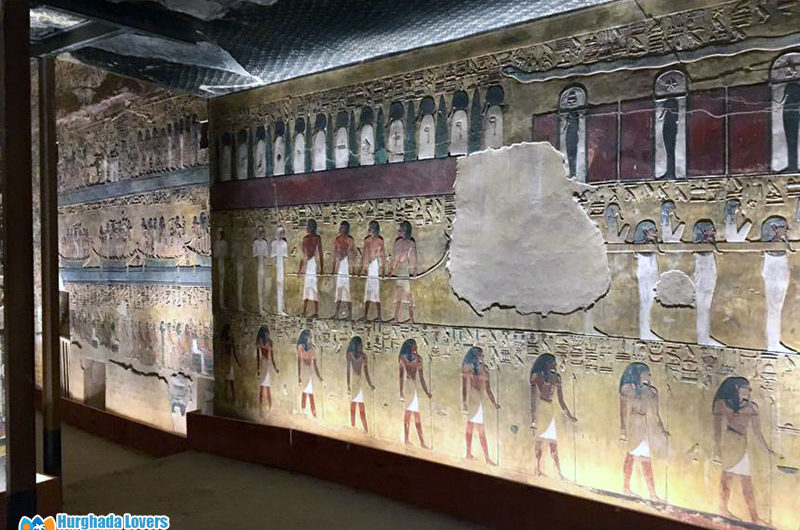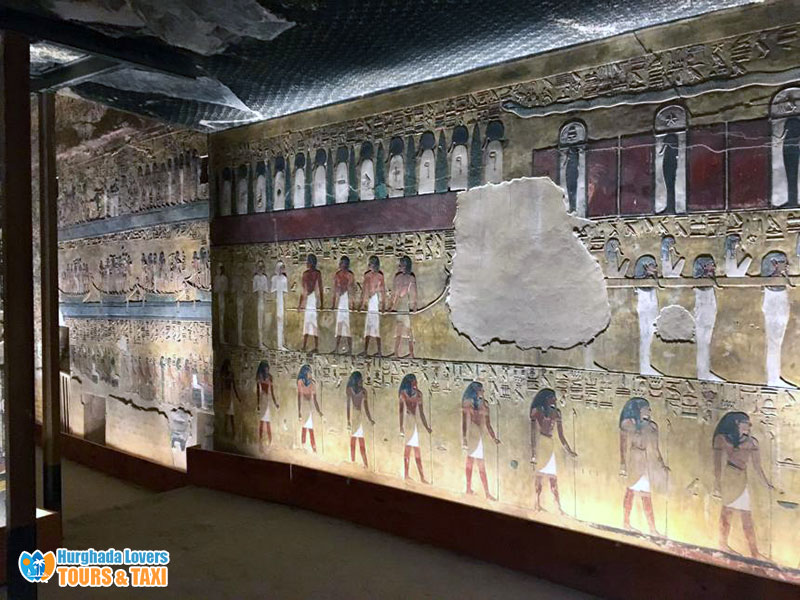Tomb of King Seti I | KV17 in Valley of the Kings, Luxor, Egypt – Egyptian Tombs
Discover the history of ancient Egyptian civilization “Ancient Egypt History” and the most beautiful royal Egyptian Pharaonic tombs in terms of decorations and Pharaonic engravings on the walls to tell us the secrets of the history of Pharaonic civilization and what are the prices of entrance tickets and visiting hours and more to start your tourist trip and visit the distinctive tourist attractions in Luxor in addition to learning about the archaeological tourist attractions in Egypt..
Tomb of King Seti I Facts
The tomb is 19 meters long and was carved into the mountain rock during the era of the Nineteenth Dynasty of Egypt, during The New Kingdom era in Ancient Egypt.
The tomb contains inscriptions in Ancient Egyptian Language from The Book of the Dead, Book of Gates and the Book of the Afterlife “Book of Amduat” to help the Pharaohs king in the afterlife “Aru“
The king’s burial chamber contains inscriptions, astronomical scenes, constellations, stars and planets to illustrate the development of astronomy among the pharaohs, in addition to columns depicting the king with religious beliefs and Egyptian deities – Ancient Egyptian gods and Goddesses.
The tomb contains a long and deep crypt, which no one has yet been able to reach the end of and discover the secrets inside, indicating the development of Architecture in ancient Egypt.
Cemetery number= KV17.
The tomb of King Seti I, the most famous of the Egyptian Pharaohs kings, is considered the longest tomb in the Valley of the Kings, as the length of the tomb is 137.19 meters.
The tomb contains a passage after the burial chamber, the pharaonic Ancient Egyptian Coffins of King Seti I was discovered in the passage.
Sir John Soane purchased the coffin of King Seti I from The British Museum after its display in the museum was rejected..
The tomb suffered significant damage to the wall inscriptions due to Jean-François Champollion removing a large area of the Pharaonic inscription, 2 metres long and 1 metre wide, to use in his Egyptology research..
A group of the German mission stole the king’s belongings and displayed them in the Louvre Museum, the National Museum in Florence, and in Berlin, which caused the loss of many secrets of King Seti I, one of the most famous ancient pharaohs throughout history..
As a result of excavation and digging operations in the tomb, the walls of the tomb were exposed to cracks and changes in the level of humidity and water between the walls, which helped to damage the Pharaonic drawings and inscriptions on the walls..
The tomb contains a crypt after the burial chamber with a length of 136 meters. A team of researchers is currently carrying out a complete restoration of the crypt to reach its end, as it is believed to contain all the Pharaonic Egyptian Antiquities, treasures and statues of King Seti I.
Which the workers feared from the Pharaonic Ancient Egyptian Grave Robbers during the period of chaos and Revolutions in Ancient Egypt and the failure to implement justice and Law in Ancient Egypt, which was symbolized by the god Maat, as in the Ancient Egyptian religion.
The tomb of Seti I was robbed by the pharaohs’ tomb robbers who were prevalent at that time..
Who discovered the tomb of Seti I?
The tomb was discovered in 1817 AD by archaeologist Giovanni Battista Belzoni, then by English archaeologist and Egyptologists Howard Carter, who discovered the Tomb of Tutankhamun | KV62, which was built during the reign of King Tutankhamun in 1902 AD..
The tomb was called the Apis Tomb due to the discovery of a bull mummy in a room next to the burial chamber. The Apis bull is one of the sacred religious beliefs of the ancient Egyptian civilization..
It was called the “Belzoni Tomb” after its discoverer, the Italian archaeologist Giovanni Battista Belzoni..
Map of the interior of the tomb of Seti I:
The design of the tomb of Seti I contains 7 corridors and 11 rooms with pharaonic inscriptions of funerary texts and a burial chamber in addition to a long corridor down after the burial chamber, the end of which has not yet been discovered..
The unique design of the burial chamber among the royal tombs in the Valley of the Kings, as the burial chamber is domed..
The depth of the underground cemetery reaches 30 meters..
The tomb was carved entirely into the rock in the Valley of the Kings..
Inscriptions and decorations of the tomb of King Seti I:
The tomb of King Seti I (Temple of Seti I is one of the most famous Mortuary Temples in Thebes) is considered one of the most beautiful royal tombs in the Valley of the Kings, as it contains inscriptions on the walls from the Book of Gates, the Book of the Dead, the Book of the Emu Duat, and the king’s journey after death, as was believed in the Pharaonic civilization..
The walls of the rooms contain an inscription of the ritual of opening the mouth of the deceased for the afterlife..
The walls of the tomb contain an inscription from the ancient Egyptian The Book of the Heavenly Cow.
You will see on the ceiling of the tomb an astronomical inscription and unique astronomical drawings that indicate the development of Ancient Egyptian science.
When the tomb of Seti I was first discovered, all the decorations and pharaonic inscriptions on the walls were in excellent condition as if they had been painted a short time ago.
However, with the passage of time, the high humidity in the rooms, and the poor restoration work by researchers in the nineteenth century AD, the colors were affected and some damage occurred to the drawings, which led the Egyptian government and the Egyptian Ministry of Tourism and Antiquities to close the tomb for a period. It is currently available to visitors..
Mummy of King Seti I:
The mummy of King Seti I was discovered in 1886 AD, beheaded, in the tombs of Deir El Bahari in the ancient city of Thebes..
The mummy’s coffin is currently on display at the Soane Museum in London, Britain. It is made of alabaster, the most famous of the Ancient Egyptian Metallurgy, and consists of one piece..
Facts about King Seti I
He received the official Coronation of the Pharaohs after the death of his father, King Ramses I, the most famous of the pharaohs and founder of the Nineteenth Egyptian Dynasty..
Egypt witnessed a lot of chaos and conflicts on the borders and revolutions in the regions of Upper and Lower Egypt, especially after the death of King Akhenaten and the religious monotheism revolution he carried out and his move to Tell el-Amarna, and the sudden death of his son King Tutankhamun and the short reign of King Ay and King Horemheb..
King Seti I unified the regions and strengthened the Military of ancient Egypt.
After that, he began to carry out military campaigns against the Bedouin tribes of Shasu, Lubia, and Kheta on the borders to fight the enemies and defeated them..
King Seti I was interested in restoring and developing the funerary temples in the ancient Egyptian pilgrimage city of Abydos, as the Abydos area is considered the birthplace of the God Osiris and became a religiously sacred area for the ancient Egyptians..
To improve the religious conditions in the country, the king developed and restored all the funerary temples of all the ancient Egyptian gods, religious beliefs and deities in the city of Memphis in northern Egypt and the city of Thebes in the south..
Reign in Ancient Egypt “Ancient Egyptian Government“: 1290 – 1279 BC.
Pharaonic Dynasty: Dynasty 19.
Children:
Princess Hanut Mere
Father: King Ramesses I
Mother: Queen Sat-Ra, the most famous queen of Pharaonic Egypt “Female Pharaohs“.
Wife: Queen Tuya
Date of death: 1279 BC.
King Seti I died at the age of 40..
Burial place: Tomb No. 17 in the Valley of the Kings, Luxor.
The effects of King Seti I:
- Temple of Seti I
- Abydos Temple in Sohag
- Hypostyle Hall of Karnak Temple Complex
Tomb of Seti I Address:
Eastern Valley Valley of the Kings in Luxor, Egypt
Visiting hours:
Daily 6:00 AM – 5:00 PM
Tomb of Seti I Entrance Ticket Prices
Note: Facts and secrets of the history will be added soon…
Hurghada Excursions Lovers, Best Travel Agency in Hurghada to provide daily tours to visit the Tourist attractions of Luxor by Hurghada to Luxor Tours and Hurghada to Pyramids Trips. Book online when you come to Hurghada, El Gouna, Sahl Hashish, Makadi Bay, Soma Bay, Egypt Tours Packages.
Tomb of King Sethi I KV17 Luxor Egypt | Seti I or Sety Pharaonic royal tombs the Valley of the Kings

